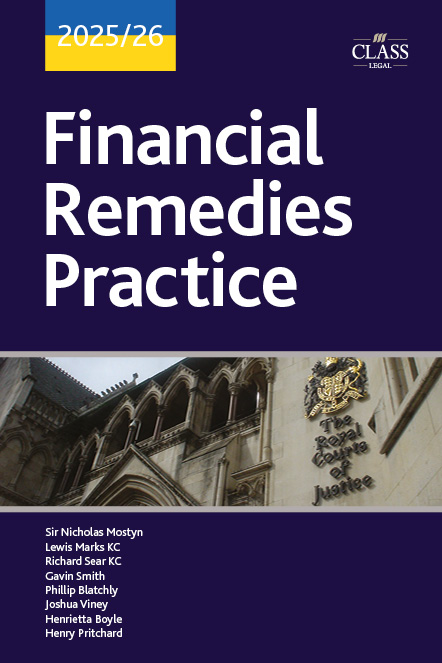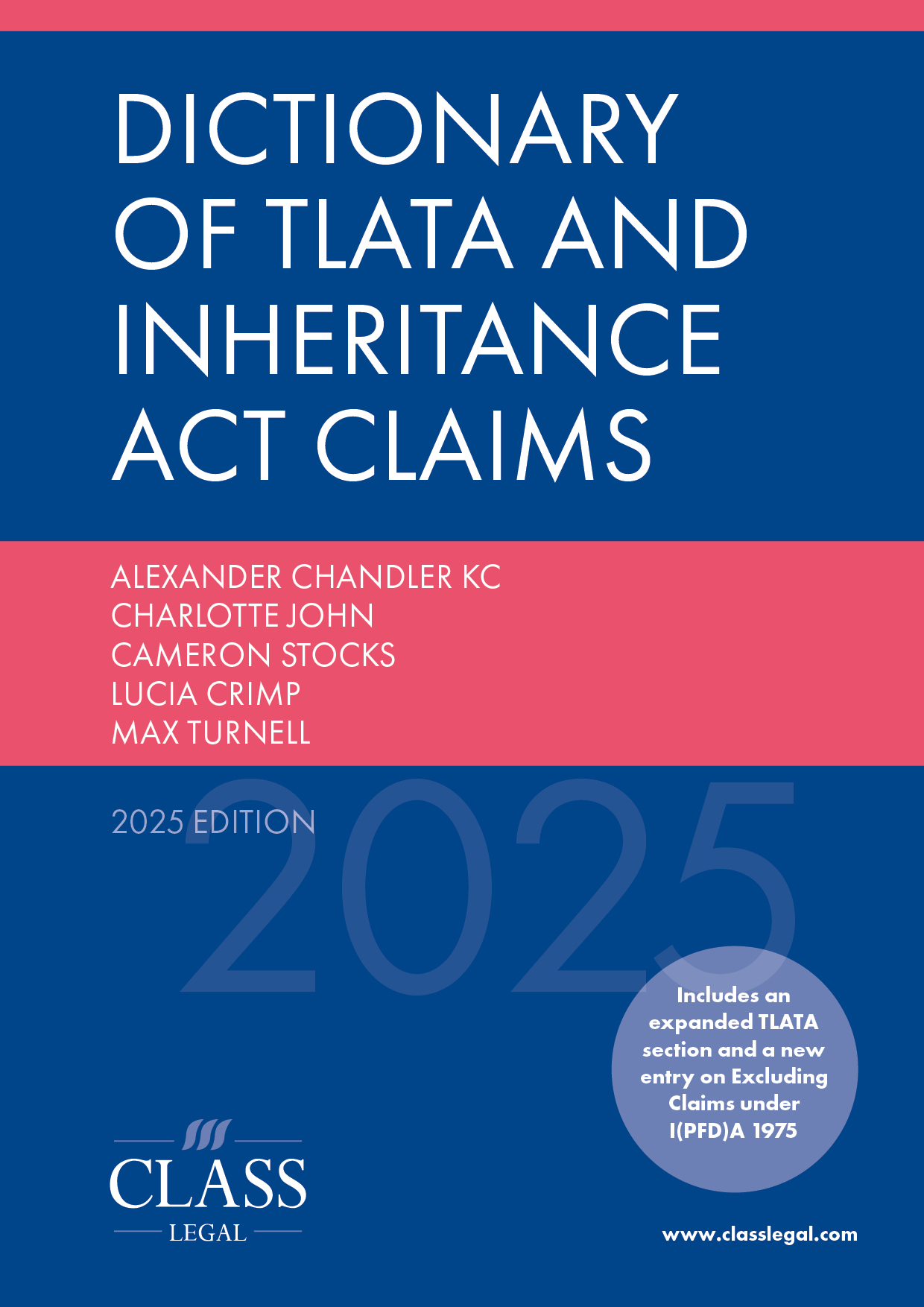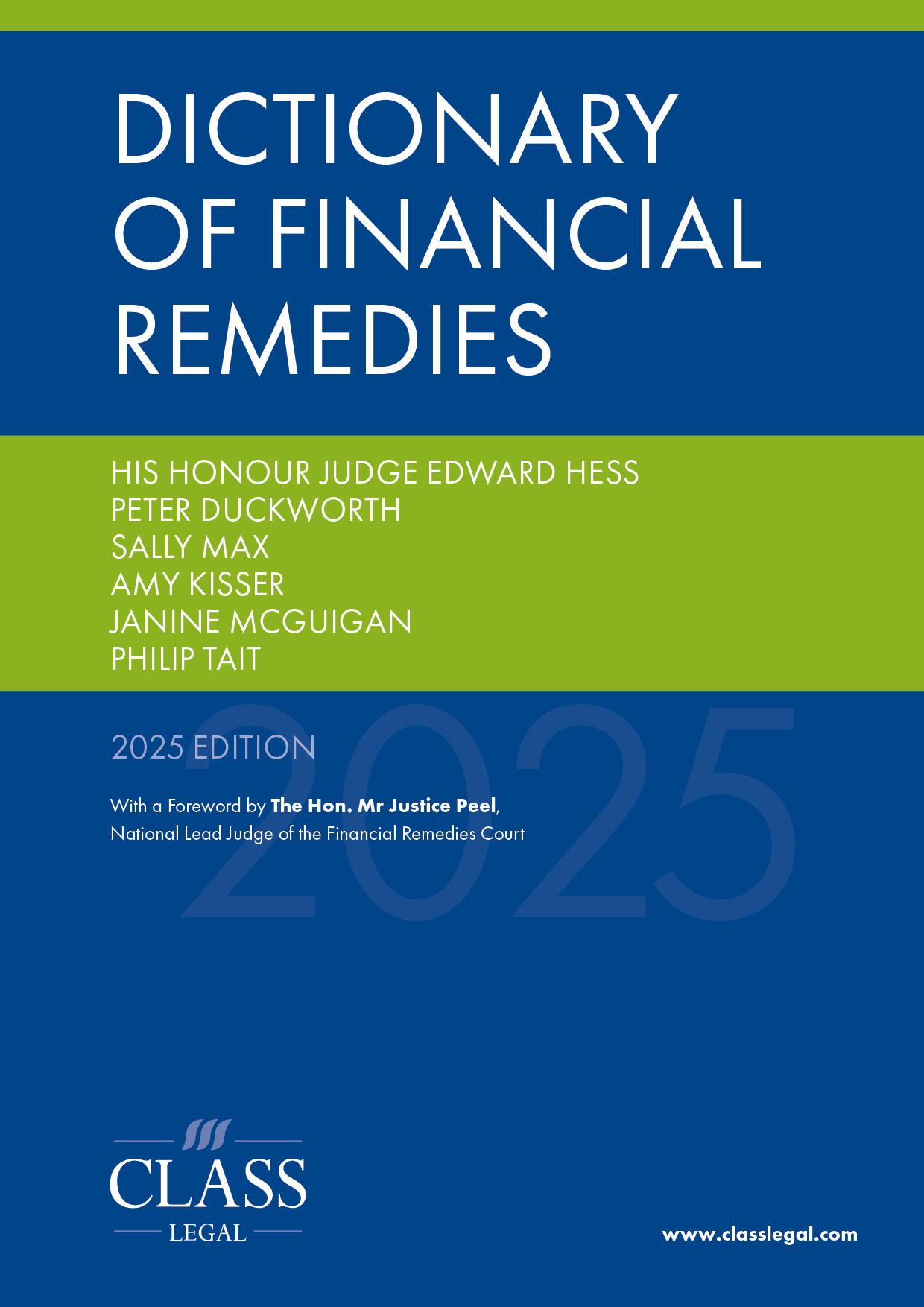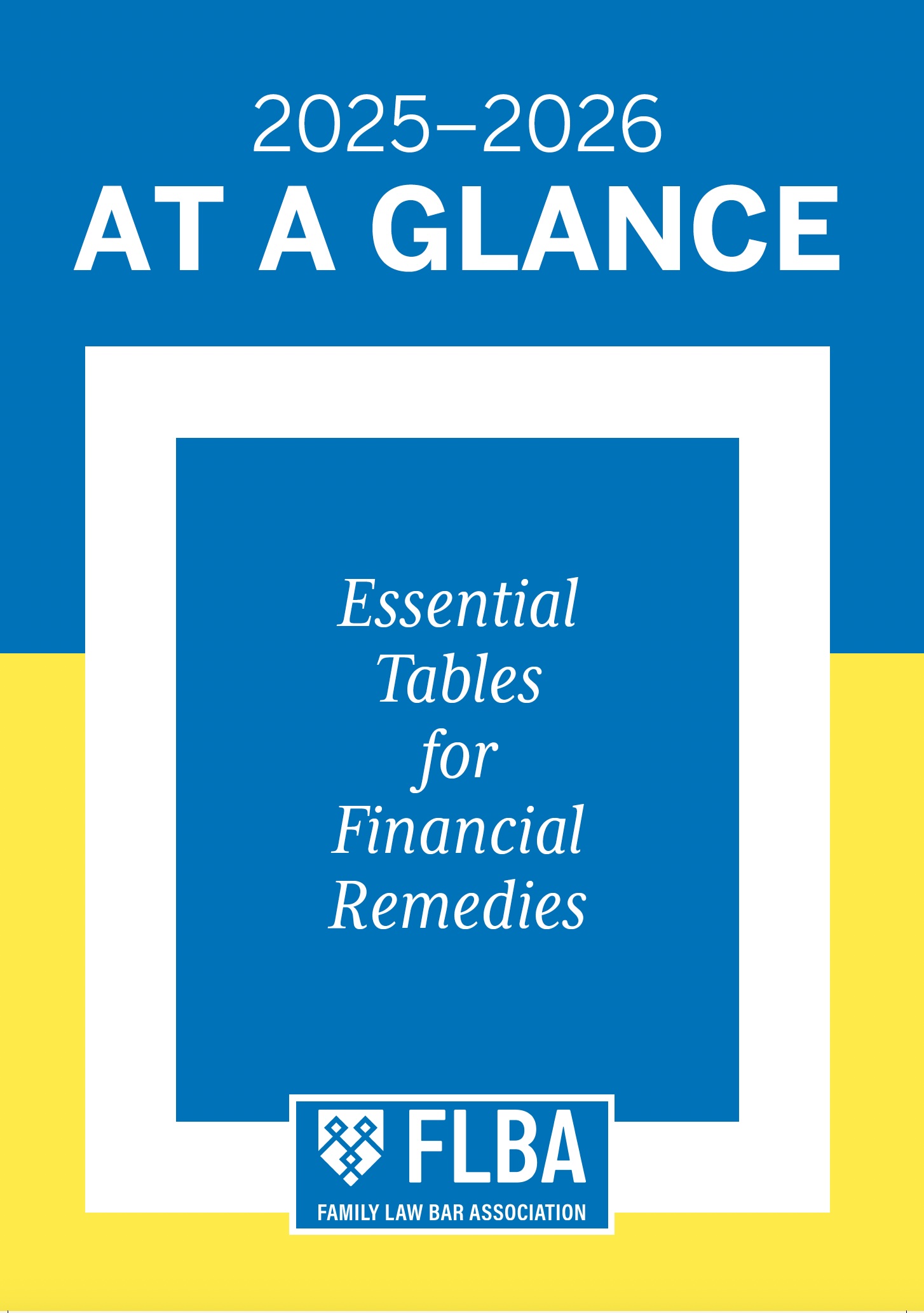
Reflections on the Law Commission Paper Financial remedies on divorce and dissolution: a scoping report published on 18 December 2024
Published: 18/03/2025 06:00

Whilst the figures do vary from year to year, a broad perusal of the official statistics suggests that each year in England and Wales approximately 250,000 couples get married and approximately 100,000 applications for a divorce (formerly divorce petitions) are made. Almost all divorce applications conclude with a final divorce order (formerly decree absolute). Of these divorced couples, a surprisingly low figure of approximately 45,000 (less than half) obtain a financial remedies order which governs their financial relationship after the divorce. Of those 45,000 financial remedies orders, approximately 32,000 are compromised before they reach the court and the court’s involvement is solely to approve a consent order. The remaining approximately 13,000 couples commence contested proceedings. Of those 13,000 couples, approximately 3,000 (between 20% and 25%) take their dispute to a contested final hearing, more than 75% compromising their dispute along the way, most commonly at the FDR stage (whether at a private or court-based FDR).
It can reasonably be supposed that to a substantial portion of the 45,000 couples seeking a financial remedies order, what the law entitles them to receive in terms of money and property is a matter of great importance at what must often be a difficult and painful moment in their lives. Given that these will be a different cohort of 45,000 couples each year, it can readily be seen that these issues are likely to be very important to a great number of people at some point in their respective lives. The principles which underpin their legal entitlements are therefore a matter of great public importance. In the circumstances, it was entirely appropriate for all those involved in the work of the world of financial remedies, judges and practitioners alike, to welcome the announcement on 3 April 2023 that the Law Commission had been invited ‘to review the laws which determine how finances are divided among couples after divorce’ with the target of producing a ‘scoping report’.
In the year and a half which has followed, the Law Commission team, very ably led by Professor Nicholas Hopkins, has carried out a major investigation with a huge amount of consultation, discussion and thought. The specialist financial remedies judiciary, led by Peel J, have fully participated in this investigation and there have been numerous meetings in which members of the judiciary have been fully engaged and consulted, alongside similar exercises with many other interested parties. This work has culminated in the production on 18 December 2024 of the promised ‘scoping report’. The diligence and expertise of the Law Commission team has been hugely impressive to witness and their appetite to explore in a great deal of detail, and with a wholly open mind, and with great insight and accuracy, many areas of financial remedies law and practice, cannot be faulted. Running to 373 pages, 324 of which represent substantive and heavily footnoted narrative analysis, HM Government can have no complaint about how the task has been performed.
In an earlier article written shortly after this announcement and published in the Financial Remedies Journal, ‘Reflections on the Recent Announcement by the Law Commission of a Review of Financial Remedies Law’ [2023] 2 FRJ 104, I set out some of my thoughts on the task which had then been given to the Law Commission and welcomed the exercise. This article is intended to be read alongside my 2023 article and to represent my reflections on the scoping report.
The real question now is where all this hard work and investigation will take us. The Protocol between the Government and the Law Commission requires the responsible minister to provide an interim response within 6 months and a final response within 12 months; but experience suggests that the giving of a governmental response to a Law Commission Report (in this area of law anyway) does not necessarily equate with decisive action. The three most recent Law Commission Reports in the area of family law, all substantive and worthy (Cohabitation: the Financial Consequences of Relationship Breakdown (2007) Law Com No 307,1 Matrimonial Property, Needs and Agreements (2014) Law Com No 343 and Enforcement of Family Financial Orders (2016) Law Com No 370), have largely gathered dust since their respective publications. It appears to be the case that the politicians (of all colours) in government since 2007 have decided that it was expedient not to pursue the reforms suggested by the Law Commission or, at least, they were not regarded by them as a sufficient priority in the context of their other tasks – doing nothing has seemed a better option.
What has happened in practice is that the statutory provisions have barely changed since 1970;2 but the way they have been utilised and interpreted by judges to promote fairness has constantly been changed and updated to reflect the very significant social changes that have occurred since the 1970s, including but not limited to the huge developments in gender equality over the period. My comment in my earlier reflections article that ‘a judge in 2023 interpreting the words of the 1973 Act, s 25 is likely to be thinking very differently from a 1973 counterpart – even though the words themselves have hardly changed (and not at all since 1984)’ is cited and acknowledged in the scoping report.3 Most obvious in this context are the judge-made changes introduced by the House of Lords in White v White [2000] UKHL 54 and Miller v Miller; McFarlane v McFarlane [2006] UKHL 24, heralding the outlawing of discrimination between earner and home-maker and the arrival of the equal sharing principle; but there are many other significant changes which can be observed in the same light, many of which can be identified in the life works of Mostyn J and his observation that ‘the law in this area is not moribund but must move to reflect changing social values’.4 It is to be observed that none of these changes required any statutory amendments to drive them.
If these judicial interventions had not happened – for example if the statutory provisions had been expressed with greater inflexibility preventing or severely limiting judicial interpretational development – then one can imagine that the calls for reform would have become irresistible long ago. In the end, though, judges are not politicians and, if politicians are not content with the measures instigated by the judges, then they can perfectly properly overrule them by targeted statutory change.
The difficulty for politicians wishing to improve things in this area is, however, well illustrated by the structure and observations of, and the breadth of options in, the scoping report. It concludes that the law does require reform, but what that reform might be ‘is a matter for Government to decide’, cautioning that the aim should be ‘to increase certainty without losing the benefits of fairness and flexibility’. In practice, the facts of particular cases can render unfair an outcome dictated by too inflexible and uncertain a general principle and the balance is thus a difficult one to strike.
The scoping report reaches the conclusion that the law requires reform, criticising the ‘do nothing’ option on the basis that the Matrimonial Causes Act 1973:
‘does not reflect the significant developments to financial remedies arising out of judicial decisions. Combined with the wide-ranging discretion contained in the current law, this means that it is not possible for an individual going through divorce to understand, by reading the statute, how their case will be decided. The law lacks certainty and accessibility to an extent that it could be argued to be inconsistent with the rule of law.’5
In support of the observation that the current law is ‘inconsistent with the rule of law’, the scoping report cites the strong and persuasive authority of some extra-judicial observations by Lord Bingham in this context:
‘the law must be accessible and so far as possible intelligible, clear and predictable … if everyone is bound by the law they must be able without undue difficulty to find out what it is, even if means taking advice (as it usually will), and the answer when given should be sufficiently clear that a course of action can be based on it.’6
Nobody would sensibly disagree with Lord Bingham’s proposition, but it is perhaps over-representing it to suggest that the necessary accessibility and clarity is to be achieved merely by reading the statute.7 Thus, the argument that the current system may be ‘inconsistent with the rule of law’ is far from pellucid (and, in fairness, the scoping report does not say that it is anything more than a possible argument). As Peel J has said:
‘I firmly believe that financial remedies law is not, or should not be, as complex as sometimes it is made out to be. Dare I suggest that the law, centred on familiar principles of sharing and (most commonly) needs, within the overarching section 25 matrix, is reasonably settled. The vast majority of cases, dealt with by specialist judges, can be dispatched relatively swiftly.’8
If the law is ‘reasonably settled’, it is surely difficult to argue that it is simultaneously ‘inconsistent with the rule of law’.
The mathematical analysis set out above – with only approximately 3,000 cases per year reaching a final hearing out of approximately 45,000 financial remedies orders per year provides some mathematical support for Peel J’s view – approximately 42,000 couples (93% of the 45,000) were able to find a consensus solution to their dispute. There is little forensic evidence supporting the proposition that the residual cases fight to the bitter end because of the uncertainty of the law as opposed to, for example, one party giving dishonest disclosure requiring forensic unpicking. If aphorisms are to be exchanged, then Baroness Deech’s contribution that ‘Most people prefer the certainty of misery to the misery of uncertainty’9 could be met by the response ‘Better the devil you know (than the devil you don’t)’.
The scoping report observes that any politician deciding to ‘do something’ has a very wide range of options. Each staging point on the range represents a different compromise of the balance between ‘certainty’ and ‘discretion’. Whilst the range of options is in reality a continuum with an infinite number of choices on it, the scoping report gathers the ‘do something’ options into four basic categories:
- Codification. This would involve accepting the current state of settled law and drafting a new statute, or a new Matrimonial Causes Act 1973, s 25, based on it, without including any provisions deliberately targeted at changing the current law. It is not clear that any government would regard this as a particularly useful exercise.10
- Codification-plus. This would involve the same exercise as codification but would include one or more targeted changes to the current law. The scoping report suggests that the targeted changes might include one or more of the following possible changes: its recommendations in the Law Commission’s earlier draft Nuptial Agreements Bill, some limitations on the duration of spousal maintenance, an extension of obligations to children over 18, an extension or otherwise of conduct and domestic abuse as a factor for the court, some automatic provisions on pension division and/or the introduction of time limitations between marital breakdown and financial remedies applications. These individual changes, all of which have powerful arguments both in support of them and against them, could of course be introduced separately on their own merits without necessarily being part of a general codification.
- Guided discretion. This would involve leaving an amended statute as a broadly expressed document but being accompanied by supplemental guidance enabling the government to give a formal steer on the principles guiding the way in which discretion is to be used. This model would presumably give greater scope for ongoing changes in the future (no formal statutory amendments being required) but there would be same choices as to what might be in the discretion – would it simply choose to adopt the current law as the discretionary guidance or would it choose to implement specific targeted changes such as the ones referred to above under codification-plus or otherwise? Guided discretion could be very general (in which case might not be very different from the current system) or might be very specific (in which case might be unfair on the facts of some cases).
- Default regime. This would or could be the most significant change – the reform of the statute to implement a default matrimonial property regime in relation to the division of capital. The default regime typically applies to all couples unless they have specifically opted out – for example to a private nuptial agreement. Within this overall category are a wide range of options as to what the default regime might be (for example, there is a choice between a deferred community of property regime and an immediate community of property regime and there are options as to what property may be held outside the community property regime), but all of them have the characteristic that the court’s discretion is limited or possibly even non-existent. Each has a different regime for spousal and child maintenance but characteristically these provisions are limited in the extent of discretion involved. The scoping report includes some interesting analysis as to how default regimes are constructed in countries such as France, Germany, Sweden, Belgium, Denmark, the Netherlands, the USA, Canada, South Africa, Australia, New Zealand and Norway,11 and notes that any system introduced needs to take into account the level of protection offered by state benefits in the country concerned to protect financially vulnerable spouses from hardship. The scoping report observes:
‘Financial remedies law is ultimately the result of deliberate choices made by individual governments in the light of their particular socio-economic contexts. The content of any default regime will be informed by the political and social imperatives of each society … stakeholders with whom we discussed the different models questioned whether the adoption of a default regime would require a greater role for maintenance. For civil society groups, this was seen as potentially problematic because of the inability to achieve a clean break, and the risk that inadequate property provision without maintenance could leave spouses vulnerable.’
The scoping report (appropriately given its terms of reference) does not seek to express any views on the best way of progressing any reform. What it does do is to highlight that each of the ‘do something’ options is likely to have its strong supporters and its strong detractors – the report observes the competing arguments in each opposing direction. Any reform is unlikely to be easy or comfortable. A decision to pursue something at the codification end of the scale would receive opposition from those who strongly favour a strong move towards clarity and certainty. A decision to pursue something at the default regime end of the scale would receive opposition from those who think that judicial discretion and fairness run hand in hand together. It will be interesting to see how the government responds to this; but it would perhaps not be altogether surprising if the decision is in the end to ‘let sleeping dogs lie’. In this context it should be noted that the review which produced the scoping report was prompted by the decisions and possible social objectives of the previous government and not the current government, whose public pronouncements suggest they may have greater interest in the reform of the law for cohabitants than for divorcing couples.12
It occurs to me that one difficulty for anybody contemplating acting in this area is a shortage of proper research information in two key areas.
First, there is a common anecdotal perception that couples going through this process, particularly those who never compromise and go through to a final contested hearing, incur substantial and sometimes ruinous cost bills, often at a level which is not proportionate to the amounts really in dispute. This suggestion is repeated many times in the scoping paper and, to some, this provides definite evidence that there is too much judicial discretion and too little statutory certainty and ample justification for reform. The incurring of depressingly large costs bills is undoubtedly exactly what happens in some cases, and many of these examples appear in reported cases, and I have had cause to comment on it in a number of my own judgments; but would a different substantive regime for the outcome of cases really change this? Is there a danger here of an application of the rule of thumb often attributed to the late Joseph Jackson QC to the effect that each new statute represents another 10 years’ work for the family bar? The position is much more nuanced in reality. Lawyers’ fees do vary hugely (geographically, in charging rates and in a willingness to self-impose a discipline of proportionality). A litigant-in-person may carry a case through to its end without incurring huge costs. Further, sometimes costs bills are front-ended so that large costs bills are incurred before a compromise is reached, perhaps at a private FDR, perhaps before the parties have been anywhere near a court. Would any of this really change if there was a different outcome regime? Are there different costs procedures – for example the introduction of a fixed costs regime – which would make this better? There is a paucity of information about the actual incidence of costs bills and the reason for it.13 There is also little research on the stage at which these costs are incurred and the reasons why they are sometimes very high – is this really anything to do with the level of discretion available in the current substantive law? Linked to this is the fact that there is not enough proper information about what methodology of dispute resolution is the most cost-effective. How many cases settle and at what point via the different methods of dispute resolution – mediation, single lawyering, private FDRs, court-based FDRs – and at what cost? Are private FDRs more successful and better value than court-based FDRs? The analysis in The Nuffield Foundation’s Fair Shares Project14 found that a significant number of divorcing couples spent surprisingly little on their financial disputes, but does it follow from this that these people had a better or worse experience of the substantive law or does this really point to the desirability of making legal aid available to those who need it?
Secondly, there is an inadequate level of research on the subject of what couples are actually agreeing in their consent orders. The Form D81 introduced in 2022 was specifically designed so that data could be ‘harvested’ so that with sophisticated AI analysis of the data, it would be possible to find out how couples are, in real life, structuring their agreements. Academics in this area have suggested that, with enough data analysed, a suitably designed AI programme could be designed so that it could independently suggest a ‘fair’ outcome on the facts of a particular case. Since the new Form D81 was introduced, more than 100,000 consent orders have been lodged and approved on the consent order portal, but no way has yet been found to harvest this data. The reason is that no funding has been found for such a project, despite the active support of the former Chair of the Law Commission (Green LJ) and Mostyn J and Peel J (as National Lead FRC Judges).
It may be that, before any wholesale reform of substantive financial remedies law is attempted, funding could be found for research in these areas. Such research should cast more light than is currently available on the bewilderingly large range of choices which the government now has in responding to the Law Commission’s scoping report. Like all financial remedies judges, I will be watching how the government responds to the Law Commission scoping report with great interest.










